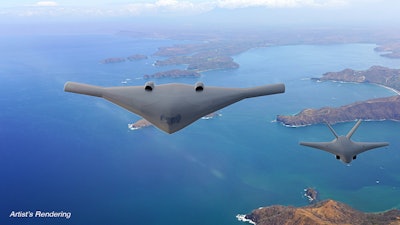
Boeing company Aurora Flight Sciences announced the design of an X-plane that uses fan-in-wing technology to provide high-speed, runway-independent mobility for contested environments.
The company released renderings of the vertical lift concept, which depict a scalable technology for airborne logistics and personnel recovery missions in locations without a prepared runway.
Most Read on Manufacturing.net
- WATCH: Bankrupt EV Maker Leaves Abandoned HQ in Shambles
- WATCH: Barge Crash Caused by Sleeping Deckhand Results in $6M in Damages
- PODCAST: Baxter Closes Biggest Factory; CEO Ordered to Return Yacht; Milford Turns 100
- WATCH: Home Depot to Force Corporate Staff to Work Shifts in Stores
The design work is part of the DARPA Speed and Runway Independent Technologies (SPRINT) program. The program aims to design, build and fly an X-plane to demonstrate the key technologies and integrated concepts that enable a transformational combination of aircraft speed and runway independence.
 Aurora Flight Sciences
Aurora Flight Sciences
Aurora and Boeing are collaborating on the development of key technologies that combine to deliver a revolutionary solution to mobility challenges in contested environments and across distributed military bases. Fan-in-wing (FIW) technology combines an embedded lift fan with a blended wing body design to enable vertical lift agility without sacrificing the payload capacity and aerodynamic efficiency associated with today’s fixed wing aircraft.
The team is currently designing an uncrewed demonstrator with a 45-foot wingspan and a 1,000-pound payload capacity. The propulsion system includes off-the-shelf turbofan and turboshaft engines that would power the vehicle to a maximum of 450 knots true airspeed.
 Aurora’s “vision system” concept, showing SPRINT technologies scaled for use in larger aircraft.Aurora Flight Sciences
Aurora’s “vision system” concept, showing SPRINT technologies scaled for use in larger aircraft.Aurora Flight Sciences
The technology demonstrated in the SPRINT X-plane could be scaled to medium and heavy lift aircraft, creating a future family of systems.
For example, Aurora envisions a manned, 130-foot wingspan aircraft with four lift fans and 40-foot payload bay. The FIW aircraft could meet or exceed the payloads, ranges and speeds typical of fixed wing military transport aircraft while delivering the tactical advantage of true vertical takeoff and landing.
Earlier this year, the team completed the first of three major test events scheduled for the current phase of the SPRINT program to prove out the feasibility of the FIW technology.
 Aurora Flight Sciences
Aurora Flight Sciences
The ground effect test, conducted using a 4.6-foot wingspan model with three lift fans, showed that suck down effects created by the lift fans in hover were negligible and that the landing gear is set to the appropriate height to minimize adverse pitching moments from forming during ground operations.
Wind tunnel tests planned for late 2024 and early 2025 include a stability and control test using a 9-foot full wingspan aircraft model and a 5.25-foot semi-span embedded lift fan test to model aerodynamic effects.
The current phase of the program continues through May 2025 with preliminary design review scheduled for April 2025.
Flight testing for the program is planned for 2027.
Click here to subscribe to our daily newsletter featuring breaking manufacturing industry news.






















